Pekka Buttler, July-November 2020

The 35 mm focal length (62° angle-of-view) has always been one of my favourites. 62° is a fair bit wider than 46° (which is the angle a 50 mm standard lens gives you), while still being significantly narrower than 74° (a 28 mm lens). 35 mm stands between the standard lens and the classic wide-angle lens (28 mm). One could – with good reason – call the 35mm lens the wide standard.
Not only do I subjectively like the angle-of-view a 35 mm lens gives you, I find the focal length to be very versatile. It’s wide enough to capture some vistas, while – if your subject is comfortable with you – it can easily work as a portrait lens, offering a less ordinary (and thus striking) relationship between subject and background.
The one problem which a moderate wide-angle such as the 35mm is, that gaining a sufficiently narrow depth-of-field, thus enabling a distinct subject separation, necessitates a really fast (wide aperture) 35 mm lens. This comparison focuses on exactly such legacy lenses.
This is a big article, which has been subdivided into several parts for convenience and the sake of humane loading times. See table of contents below.
• Part 1: Introduction, the lenses: pedigree and handling (you are here)
• Part 2: IQ-comparison I – The Brick wall test
• Part 3: IQ comparison II – Urban vistas
• Part 4: IQ-comparison III – Bokeh and feel
• Part 5: IQ-comparison IV – Night-time vistas
• Part 6: Summary and conclusions
P.S. If you have not yet acquainted yourself with the principles and rationales for reviews and comparisons used at JAPB, have a look here. But just in case you did not bother to read that, remember that we are reviewing and comparing samples of lenses and our comments and conclusions invariably apply only to the samples we have.
The lenses – selection criteria
First question: What qualifies as a fast 35 mm legacy lens? Certainly, the lens needs to be faster (have a wider maximum aperture) than f/2.8, preferably a lot faster. In practical terms though, the very nature of a 35 mm (full frame) lens puts some limits on the maximum aperture. Therefore, considering design ramifications, a f/2 35 mm lens is a fast 35 mm lens.
This comparison was therefore set up to only compare 35 mm lenses with a maximum aperture of f/2 or faster. Looking at the lenses I had on hand, this resulted in an obvious sample of 8 lenses. After some more consideration, I decided to also include one somewhat slower lens (The Carl Zeiss Jena Prakticar (Flektogon) 35 mm f/2.4). This choice was based on that I wanted to rigorously compare the ‘Flek’ with some other fast lenses I had, partially to highlight what you (in some situations) can get with an f/2, which you cannot with an f/2.4.
The final list of lenses therefore was (alphabetical):
• Canon FD 35 mm f/2 (concave) (FD-mount)
• Carl Zeiss Jena 35 mm f/2.4 (Praktica B -mount)
• Konica Hexanon AR 35 mm f/2 (Konica AR -mount)
• Minolta MD Rokkor 35 mm f/1.8 (Minolta SR -mount)
• MIR 24N 35 mm f/2 (Nikon F -mount)
• Nikkor Ai 35 mm f/1.4 (Nikon F -mount)
• Nikkor Ai 35 mm f/2 (Nikon F -mount)
• Nikkor AF-D 35 mm f/2 (Nikkor F-mount)
• Porst 35 mm f/1.8 MC (M42-mount)
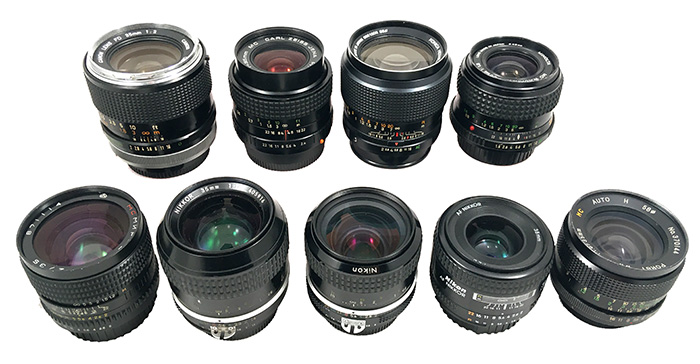
MIR, Nikon Ai f/1.4, Nikon Ai f/2, Nikon AF-D, Porst
As always, I’m working with lenses I have on hand. Hence, this comparison is neither complete, nor do I manage to compare all the interesting alternatives. Even so, I hope it will prove both enlightening and useful.
Next we’re going to have a brief look into these lenses in slightly more detail.
n.B! About other obvious worthy contenders: As said, this comparison is based on the lenses I have on hand, and can therefore not be complete. That said, some lenses are worth mentioning in that I would have wished to have them on hand as well, most prominently the Olympus and Takumar/Pentax 35/2 lenses. Furthermore, there are a number of other (besides the Porst) fast 35 mm third party lenses (such as a very reputable Vivitar 35/1.9), which – again – I do not have on hand. Note also, that as the purpose was to compare legacy lenses, no modern (current), fast 35 mm lenses were included.
Lens characteristics and handling
Interestingly, these nine lenses constitute a quite varied bunch. While they all have numerically identical focal lengths (and angles of view), one of the lenses sports the max aperture of f/1.4, two have a max aperture of f/1.8 and one is a relatively slow lens (at f/2.4), with the remaining five lenses offering a max aperture of f/2. Moreover, in many other ways, these lenses are quite varied. While lenses are made for rendering an image, and the qualities of that image is undoubtedly important, so too are many other aspects.
Therefore, before going on to look at image quality, let’s have a look at the other characteristics of these lenses. Remember, unless otherwise stated, each sample has no distinguishable failings.
Canon FD 35 mm f/2 (concave) [data sheet]
Depending on the source, Canon manufactured between six and eight different versions of the 35/2 during the FD and FDn -era (two sources mention 6 versions, but the demarcation lines differ to such an extent, that there may be 6, 7 or 8 identifiable versions). The earliest versions sport a chrome nose ring, the middle versions are black-nose FD versions, whereas the last versions are typical FDn versions (all black, no breech-lock ring, obvious use of plastics). Likewise, it seems that Canon experimented with (at least) three optical designs. The first design uses a concave (inward-bulging) front element and thoriated glass (and is thus mildly radioactive), and sports a min aperture of f/16, whereas all later designs offer a min aperture of f/22.
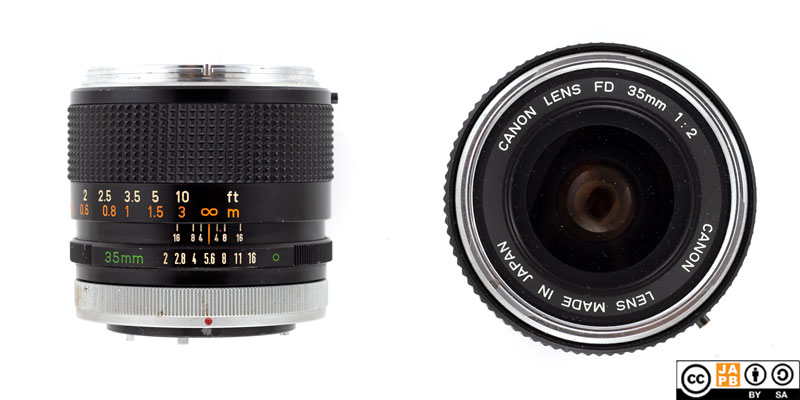
The tested sample (serial no. 25715) is a relatively early version, and sports a chrome nose ring. It has an 9 lens elements in 8 groups and an eight-bladed aperture. Interestingly, the sample lens’ weight (measured at 511 grams) exceeds Canon specifications (420 g) significantly. This is a hefty lens, and is liable to result in a front-heavy combination on any mirrorless interchangeable lens camera. Also, the lens is by no means small: It’s filter ring is 55 mm, and at 63 mm long, it is not especially short either. While it lacks the requisite markings denoting super-spectra coating, the coating has the same looks as S.S.C marked lenses typically have.
Whereas Canon’s aptitude in designing optics and coatings undoubtedly improved throughout the FD/FDn -era, the shift towards plastics and an overall lighter build did come at a cost in build quality. No quality-worries with this sample though: The aperture ring moves smoothly, and is supplied with half-stop clicks throughout the range. The focus ring is somewhat on the heavy side, but moves supremely smoothly. Unusually for its era (early 1970’s), it even has the arrangement to receive a bayonet-type hood. With a MFD of 0,3 meters (resulting in a max magnification of 1:5) it is not a macro lens.
Personally, I’m not enamoured of FD and FDn lenses on anything but Canon FL/FD/FDn bodies because I find the adapters and their aperture engagement rings to be finicky and liable to produce unreliable results (you can read more about that here).
Read more (elsewhere):
Canon Camera museum
Lummukka.com
Carl Zeiss Jena Prakticar 35 mm f/2.4 MC [data sheet]
This lens might be unknown to many, but in essence, it is the last iteration of the 35 mm Carl Zeiss Jena Flektogon (Carl Zeiss Jena being the East German arm of the pre-war, unified Carl-Zeiss). ‘Flektogon’ itself is the designation given (by CZJ) for a class of wide-angle SLR lenses (just as Carl Zeiss of West Germany refers to their similarly-purposed designs as ‘Distagon’). CZJ manufactured Flektogon designs in both 35 mm, 25 mm and 20 mm focal lengths (for 35 mm film – medium format Flektogons naturally had longer focal lengths). Of these the 25 mm Flektogon is quite rare, and while 20 mm Flektogons (both in f/4 and F/2.8 versions) show up on local markets now and then, the 35 mm ‘Flek’ is clearly the most common version.
There were two major design iterations of the 35 mm focal length Flektogon: Early lenses sported a max aperture of f/2.8 and came in silver, ‘zebra’ or chrome band (als known a ‘rubber band’) finish for Exakta and M42 mounts, while later f/2.4 versions were in all-black finish for M42 and Praktica B -mount. All versions are relatively highly rated.
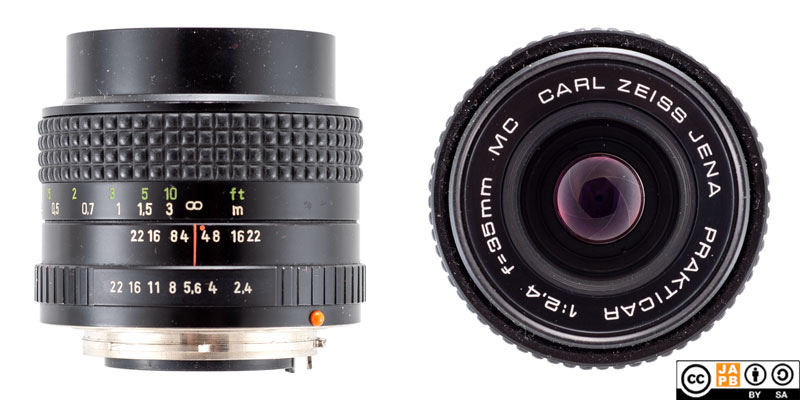
This sample (#4083) is a last generation Praktica B-mount sample (hence the name ‘Prakticar’). It has a 6 elements in 6 groups -design and a 6-blade aperture. At 239 grams (measured) it is one of the lighter and at a length of 55 mm also shorter designs in the selection. Its 49 mm filter ring is among the smaller. What really sets the Flektogon apart (besides its relative slowness and East German origin) is its, relatively speaking, ridiculously short MFD of just 0,219 meters, resulting in a lens which – while still short of macro capabilities – offers significant versatility.
The build quality of this sample shows that also East German lenses stopped being designed like tanks as it seems every gram has been questioned. Even so the mount is metal, all outward-facing elements of the lens barrel are metal (or rubber), and while this late ‘Flek’ certainly feels more cheap and less ‘vintagey’ than earlier designs, this does not come at an apparent cost in build quality. The aperture ring moves lightly, but with distinct clicks. The focus ring moves nicely and evenly and offers roughly 190 degree focus throw.
My main usability gripe is that (somewhat typically for later-generation CZJ lenses) the aperture ring clicks do not always seem to line up perfectly with the print on the aperture ring. In the case of this sample, this is slightly exacerbated by that it has two intermediate clicks between the markings for f/2.4 and f/4.
In all, the lens has a nice size and balances well on a Sony ⍺7 -class body. Also, it handles nicely, but falls somewhat short of some of the decidedly more high build quality -contenders.
Read more (elsewhere):
Casual Photophile on the ‘Flek’
Camera Wiki
Konica Hexanon AR 35 mm f/2 [data sheet]
While Konica has been manufacturing 35 mm f/2 lenses since 1960 (for the Konica F-mount), this lens has little in common with those early version. Re-introduced in 1971, this Konica 35mm f/2 is a 9 elements in 7 groups design, with a min aperture of f/16. Over a lifespan of more than 15 years, only the lens’ outward appearance and coatings changed. All in all, the lens went through 3 distinct (outward) design iterations, with this lens being from the last iteration (all black, with rubberised focus ring). As with the competition, a common theme in these iterations was that the new design was lighter (and probably cheaper to manufacture). Unlike some of its main competitors, Konica never went for the extensive use of plastics in their lenses.
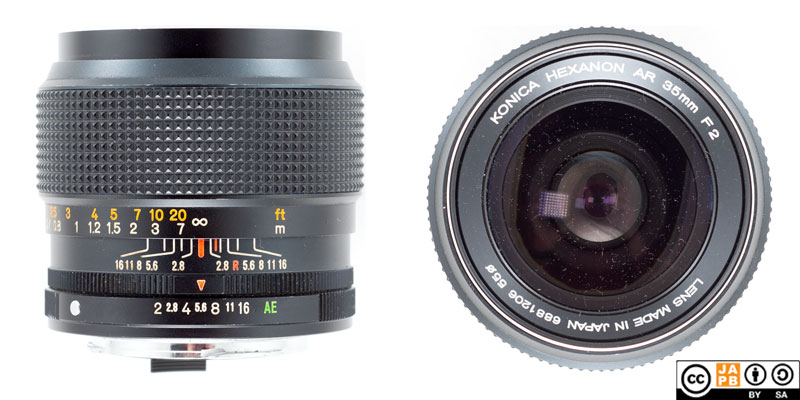
The tested sample (#6881206) is very similar in size to the Canon FD 35/2 , but weighs only 286 grams. Even so its barrel is entirely metal. Thanks to the shorter flange focal distance of the Konica AR system, and its relatively low weight, it manages to produce a far more well-balanced package (on a Sony ⍺7 body) than the more hefty Canon FD lens.
The lens has a beautiful, broad focusing ring, and while one could wish for a softer, more grippy rubber compound, this focus ring is one of the most usable in the selection. Regarding the aperture ring’s functionality, there are two/three types of lenses branded as ‘Konica Hexanon’. Firstly, not all Konica-branded lenses were manufactured my Konica themselves, as especially in the later days Konica extensively utilised Tokina lenses. Tokina-made Konica lenses typically have a relatively pleasant and functional aperture ring, whereas Konica aperture rings often feel so rough one might easily think they’re broken. With lenses using Konica’s own design and manufacturing (such as this), there are lenses which have only full stop-clicks and those which also offer half-stop clicks. Luckily, this design offers half-stop clicks.
Full disclosure: The lens arrived at my doorstep in a deplorable state, with aperture blades stuck due to oil and a raspy focusing helicoid. After a thorough DIY-CLA, the lens now seems to be in order and the test results confirm – if nothing else – that I managed to reassemble the lens correctly 😉
Read more (elsewhere):
Konica Hexanon AR 35/2 on Buhla.de
Minolta MD W.Rokkor 35 mm f/1.8 [data sheet]
Unlike many of its competitors, Minolta never offered an f/2 35 mm lens. Instead, the obligatory 35/2.8 was accompanied by a slightly faster-than-normal 35/1.8 lens. From its first iteration in 1968, Minolta’s 35/1.8 went through five iterations. While each iteration brought cosmetic / ergonomic changes, only one major design change was made to the lens: The three earlier MC versions are significantly heavier and limited to a min aperture of f/16, while the later two MD versions (naturally) supported the new physical MD-interface, were significantly lighter and offered a min aperture going all the way to f/22. The MD version also had a smaller diameter filter ring (49 vs. 55 mm). Both MC and MD versions were based on a similar optical recipe (8 elements in 6 groups), but the lens was entirely redesigned when moving from MC to MD.
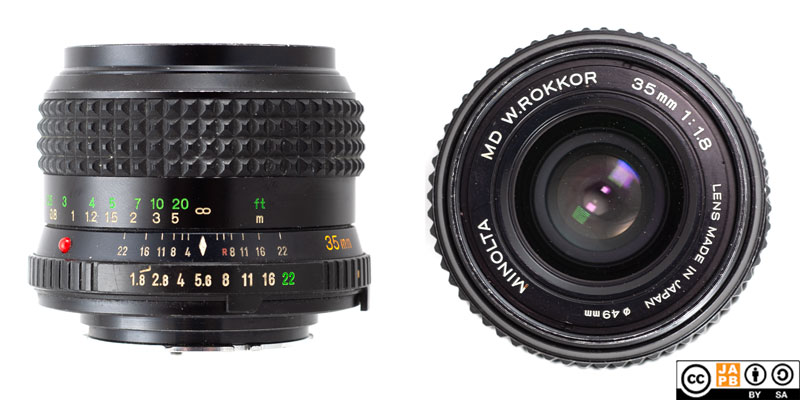
The tested sample (#2008074) is one of the MD designs, and is – despite its wider max aperture – the smallest manual focus lens in the selection, albeit only by a small margin. I remember that when I went to pick up the lens, my first reaction was: “Man, that thing is tiny.” The feeling of it being small is somewhat accentuated by its tapered design (being narrower towards the front). Similarly, it is a relatively light lens, with only the Nikon AF-D 35/2 being lighter (but that lens has an all-plastic barrel, whereas the barrel of the Minolta is metal, with the sole exception of the plastic aperture ring). While the sample is in otherwise perfect condition, it suffers a minor, and for Minolta lenses of this era, quite typical cosmetic issue, namely that its rubber focusing ring has somewhat expanded and does not sit entirely flush. Even so, the aperture ring moves nicely and while its clicks are pronounced, they’re re in no way annoying. The facet which I find most annoying (and frankly amazing) with this lens, is that it has no intermediate stops between f/1.8 and f/2.8. The focus ring moves smoothly, and has a long focus throw of 240 degrees to reach a decent MFD of 0,3 meters.
Read more (elsewhere):
MD 35/1.8 on Rokkorfiles.com
Minolta lens index
MIR 24N – 35 mm f/2 [data sheet]
Some may consider this a somewhat oddball addition to the selection, but besides fulfilling the basic requirements of having a 35 mm focal length and being respectably fast, it is in no way an unusual lens – except that it’s a Soviet, fast, wide angle lens.
The lens is available in two mounts: The MIR 24M comes in M42 mount and the MIR 24N (N is H in cyrillic, thus the lens says MIR 24H) in Nikon F mount (Ai spec.) There is a newer multicoated version (“MC”), as well as an older non-multicoated version, which is – according to some – more prone to flaring.
While previously (before the advent of mirrorless) the M42 variant was more desirable because of its easier adaptability, today that hardly is an issue. On the contrary, due to the different approaches to auto aperture between M42 and Nikon (and most other proprietary mounts), I’d say the Nikon versions are somewhat less liable to suffer issues due to lame blades.
Alike many Soviet lenses, the lens design originated in a design bureau, and the lens was then manufactured at several optical plants. The MIR 24 is known to have been manufactured at least at the Arsenal Plant (home of Arsat lenses and Kiev cameras), and at KMZ (Krasnogorskiy Mechanicheskiy Zavod, home of the Zenit‘s and Zorki‘s). According to some sources, the Nikon -mount version was manufactured by Arsenal whereas the M42 -mount version came from the KMZ plant. While Soviet lenses are notorious for dismal quality control, I personally think that reputation is somewhat exaggerated. Also, while some seem to believe that all the Soviets ever did was copy others’ designs, this lens may well be an original Soviet design, as it seems to share no characteristics of earlier western/far-east designs.
NOTE! The lens is sometimes misleadingly being offered as a Soviet/Russian Flektogon copy, which is not only a blatant attempt to achieve a price-hike, but also obviously counterfactual. Not only did the Flek never reach f/2, the entire optical design is totally dissimilar.

The tested sample (#871114) is a later-variety (multicoated) Nikon-mount lens. Judged purely on size, it looks larger than it is. In reality the barrel diameter (63 mm) is among the narrowest in the selection, and it is of medium length. On the other hand, at 323 grams, it is the third heaviest (only the FD35/2 and Nikkor 35/1,4 are heavier). The weight is due to the lens’ all-metal construction, and I must say the build quality is superb: Focus ring and aperture ring move smoothly and with a very satisfying resistance, nothing rattles, nothing wiggles and there simply is no play anywhere in the lens. On top of all that, it has a close-focus capability (0,24 m) bested only by the Flek and equalled only by the Nikkor AF-D 35/2.
Read more (elsewhere):
• Review at Lensbean
• MIR 24 on allphotolenses.com
Nikkor Ai 35 mm f/1.4 [data sheet]
If the Flektogon is an outlier due to its somewhat darker max aperture, then this lens is equally an outlier – except in the opposite direction. Af f/1.4, it is a full stop faster than the median among the selection.
Nikon has a long tradition of manufacturing 35/1.4 SLR lenses. In fact, Nikon was the first camera company to accomplish the design and manufacture of a 35 mm focal length, f/1.4 aperture SLR lens: the NIKKOR-N Auto 1:1.4 f=35mm.
Nikkor’s genealogy of 35/1.4 lenses ranges from 1970 to today, and during that time, there have been three basic designs used:
• The first design was used by the Nikkor-N 35/1.4 (Pre-Ai, metal focus ring; 1970–1976),
• The second design was used by a range of lenses (both Pre-Ai, rubber focus ring 1975–77, Ai 1977–1981 and Ai-s 1981–today), and
• The third, thoroughly modern design used by the AF-S 35/1.4 G (2010–today.)
All three designs have a MFD of ≈ 0,3 meters. (If you’re unfamiliar with the genealogy of Nikon F-mount lenses, see here)
Interestingly, this lens in its Ai-s variant (introduced 1981) is one of only two lenses in this selection still available as new today, although for the quite staggering price of 1150$
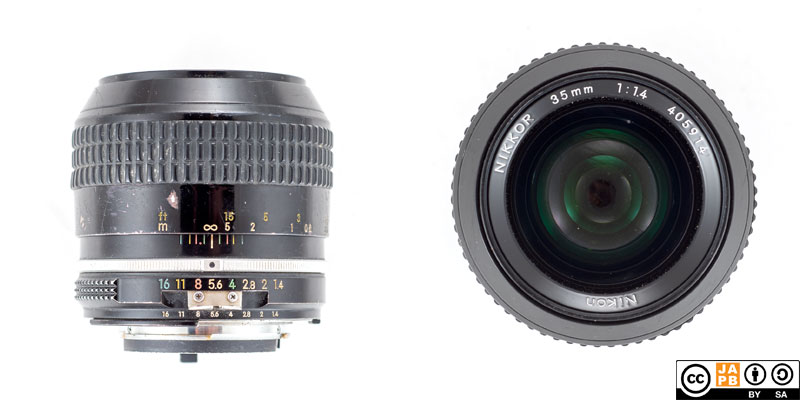
This sample (#405914) is a relatively early Ai-spec lens and differs from the later Ai-s version in having a somewhat longer focus throw, a different barrel design, in having a 7-blade (not 9-blade) iris and – obviously – not being Ai-s compliant. Both have a 9 elements in 7 groups -design. At a tad over 400 grams in weight, this is the second heaviest lens in the selection (only the FD 35/2 chrome nose is heavier), and while it certainly is on the heavy side, 100-150 extra grams is a minor price to pay for an f/1.4 lens (if you need that feature). The front element protrudes close to the edge of the filter ring, and a protective filter might be a worthwhile investment.
I admit to having been able to acquire this lens very cheaply due to some minor (and for this comparison entirely inconsequential) maladies: it is outwardly somewhat worn and its focusing ring was very stiff (an issue I have since been able to rectify). Its optics, diaphragm and aperture ring, on the other hand seem to function perfectly. While I therefore cannot comment on how its focusing ring ‘normally’ works, its aperture ring moves very nicely and just as one would expect from a premium Nikkor lens.
Read more (elsewhere):
• Nikkor – The thousand and one nights (No. 27)
• Richard Haw’s Review and repair guide (Ai-s version)
Nikkor Ai 35 mm f/2 [data sheet]
The manual focus Nikkor 35/2 is even more of a classic Nikkor lens than the f/1.4 variant. Since Nikon introduced the Nikkor-O 35 mm f/2 lens for the Nikon F mount in 1965, the design stayed unchanged (only mechanics and coatings changed) until the Ai-s version. Moreover, while this lens was overtaken (in the Nikon lens lineup) by it’s autofocus sibling (see next) in 1989, the Ai-s version stayed in production all the way until 2005. During that time, Nikon manufactured more than 400 000 of this lens in its different variants.
All these versions are characterised by an 8 element in 6 groups design, a 7-bladed iris, an MFD of 0,3 meters and a 190-195 º focus throw (except the Ai-s version, which has a 120 º focus throw)
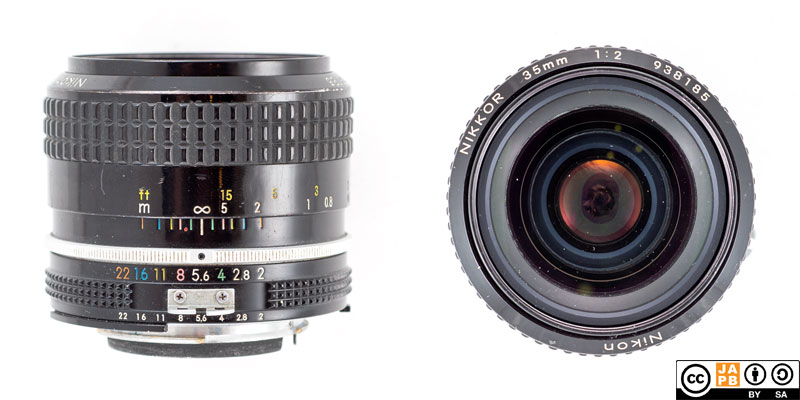
The tested sample (#936732) is a relatively early Ai -version and weighs 282 grams (measured). The lens exudes an air of being very well designed and manufactured – not only due to the smooth and well damped movement of the focus ring or the perfectly tactile aperture ring – but also thanks to its nicely proportioned overall form. This sample is outwardly in perfect shape, but does suffer from some stains on the rearmost doublet.
Read more (elsewhere):
• Pre-Ai Nikkor 35/2 at Casual Photophile
• Tai Shimizu’s review
Nikkor AF-D 35 mm f/2 [data sheet]
This lens – being an autofocus lens – is another outlier in this comparison. On the other hand, the design is more than 30 years old. Nikon introduced the original (non-D) version of this lens in 1989, as part of the second wave of autofocus lenses. From the beginning, it had a real focus ring (the earliest Nikkor AF lenses had just a flimsy, awkwardly positioned, ribbed-plastic ring for facilitating manual focus). While this later D-version (introduced 1995) added the capability to communicate distance information to the body (for improved flash metering), it is optically identical to its predecessor.
Both AF and AF-D version have a quite different optical design to their predecessor (see above): using only 6 elements in 5 groups, and with a clearly smaller front element. Both versions have a 7-bladed straight aperture.
Interestingly, also this lens is still available new, for roughly 400$/350€.
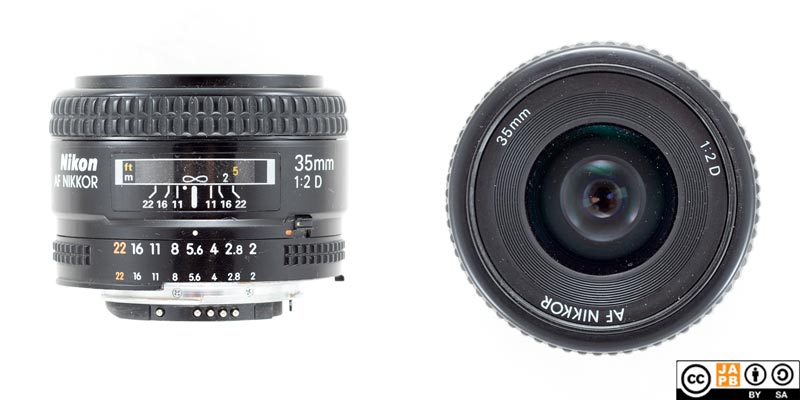
The tested sample (#527114) is probably from the late naughties, and – while the aesthetics of these lenses do tend to be divisive – is in an outwardly good shape. At 201 grams (measured) it is the lightest lens in this selection, which is probably to a significant degree thanks to its outward construction (incl. filter ring) being entirely plastic. While the focus ring is rubberised and offers good grip, it moves somewhat too lightly for my taste, but nevertheless has a relatively long focus throw (at 155 º, actually longer than its Ai-s sibling). Having been designed mainly for cameras where you control the aperture using a control dial on the camera, the aperture ring is dismal: tight, scratchy and quite reluctant. The front element protrudes close to the edge of the filter ring, and a protective filter might be a worthwhile investment.
Interestingly, this lens is typically not rated very highly – neither by Nikon AF shooters nor by manual focus aficionados – who not only decry its plastic construction and handling, but also its rather simpler optical design. This comparison will also be able to comment on whether this lens is the ‘dog’ it is supposed to be
Porst WW 35 mm f/1.8 [review]
See the JAPB company profile on Porst for more details on the company.
While Porst SLR cameras were rebrands of various well-known marques (primarily Praktica, Fuji and Cosina), Porst sourced its lenses more widely. While some of Porst lenses were direct rebrands of identical lenses of major brands (as in some cases with Fuji lenses), most were sourced from (mostly Japanese) off-brand manufacturers. Given that some major Japanese brands (as well as notably Zeiss) sub-contracted some of their lens manufacture to these same manufacturers, a lens coming from outside the hallowed grounds of big-name camera manufacturers’ is not automatically a bad thing.
That means, however, that many of the re-branders (Porst among them) may be something of a mixed bag on the legacy lens market, as you can never know whether the lens meets (or, indeed, ever met) any other standards than being available in decent quantities at an irresistible price.
The Porst WW (Weitwinkel, wide-angle) 35 mm f/1.8 is one of those lenses you may also encounter under other (re)brand names. The same lens is available (at least) under the names Weltblick, Spriratone and Formula 5. Originally, the lens seems to originate from the Japanese manufactory named Mitake Optical (not to be confused with the more contemporary Mitakon). While very little online information about the company remains, Mitake seems to have had quite an ambitious lineup, containing – not only this relatively fast 35 mm lens – but also a 28 mm f/2 and a 135 mm f/1.8. (If anyone has something more to share about Mitake, I’d be glad to hear from you).

Due to the relative dearth of information available online, I cannot reveal anything definite about the lens’ optical recipe (elements&groups), except that it has a 6-blade aperture, but the general characteristics of the lens are quite straightforward: Alike the MIR, the Porst has a big filter ring and looks somewhat bulky, while simultaneously not being especially heavy (264 g, measured). Being an M42 lens, it has the distinctive auto/manual aperture switch, which is liable to slip into auto without the photographer noticing. Otherwise the build quality and tactile features of the lens are quite good.
Full Disclosure: This lens came to me as part of an estate sale and had heavy fungus on the inside of the front element. Moreover, someone had tried to gain access to the lens innards (without success, as the way to open the lens is somewhat counter-intuitive), leaving some scratches on the lens metal front. After cleaning the lens elements, the lens seems to function quite nicely.
Read more (elsewhere):
• Porst on Camerapedia
• About ‘Mitake‘ on MFLenses
Lens characteristics and handling – summary
The nine lenses in this comparison are both similar and very different. They are similar in being 35 mm focal length primes designed for 135-format (36mm x 24 mm) film and in having reasonably wide apertures. Therefore their main similarity is that they have – at their respective times – been designed to serve similar purposes by their various manufacturers. The Konica Hexanon AR 35/2 is Konica’s solution to the same problem the Canon FD 35/2 was designed to solve, and so on. Hence, these lenses have at one stage or other competed against each other in a very real sense.
The main difference is in the different approaches these 9 lenses (from 7 manufacturers) have taken to addressing the common problem. These differences are summarized in the table below
| name | f-max | f-min | mount | length/diam.-weight | design | filter mm | MFD (m) | focus throw | € @ eBay[1] |
|---|---|---|---|---|---|---|---|---|---|
| Canon FD 35/2 ‘chrome nose’ | 2 | 16 | Canon FD | 63/66-511g | 9e / 8g | 55 | 0,29 | 180 | 220-260€ |
| CZJ Prakticar 35/2.4 MC | 2.4 | 22 | Praktica B | 55/63-259g | 6e / 6g | 49 | 0,219 | 200 | 100-120€ |
| Konica Hexanon AR 35/2 | 2 | 16 | Konica AR | 59/66-286g | 9e / 7g | 55 | 0,3 | 190 | 130-150€ |
| Minolta MD W.Rokkor 35/1.8 | 1.8 | 22 | Minolta SR (MD) | 49/65-233g | 8e / 6g | 49 | 0,3 | 240 | 120-160€ |
| MIR-24N | 2 | 22 | Nikon F (Ai) | 52/63-323g | 8e / 7g | 58 | 0,24 | 280 | 80-120€ |
| Nikkor 35/1.4 | 1.4 | 16 | Nikon F (Ai) | 62/68-404g | 9e / 7g | 52 | 0,29 | 180 | 300-400€ |
| Nikkor 35/2 | 2 | 16 | Nikon F (Ai) | 53/64-282g | 8e / 6g | 52 | 0,29 | 180 | 120-140€ |
| Nikkor AF-D 35/2 | 2 | 22 | Nikon F (AF) | 45/65-201g | 6e / 5g | 52 | 0.24 | 160 | 120-160€ |
| Porst WW 35/1.8 MC | 1.8 | 16 | M42 (M/A) | 49/64-264g | ? [2] | 58 | 0,48 | 180 | N/A [3] |
Notes:
[1] “eBay prices” reflect the cheaper end of the spectrum of recent completed sales (of items listed as in working condition) on eBay (without freight and customs). This is a price you can expect to buy the item at if you have patience to wait for a good deal. n.B! This may change quickly.
[2] No online information found. I have taken the lens apart, but made no detailed notes about design. If memory serves, the lens had 6 groups, with one maybe being a doublet. Thus either 7e / 6g or 6e / 6g, but take this with a pinch of salt.
[3] Insufficient recent sales for reference price.
Keeping in mind that all these lenses have similar defining characteristics (focal length & max aperture), the table shows significant variations. Many of these variations are not so much reflections of the lenses in themselves, but reflections of the lens lineups in question. For instance, the wide range of filter threads in evidence (49-52-55-58 mm) is not so much an indication of the various lens designs’ demands, but of the ‘normal’ filter thread of the various lens lineups (e.g. 49 mm for Minolta MD, 52 mm for Nikon, 55 mm for Canon FD and Konica AR).
Still, some noteworthy observations can be made:
• The Canon FD 35/2 ‘chrome nose’ is one heavy lens. While not especially heavy compared to modern large-aperture 35 mm lenses (e.g. the Sigma 35/1.4 Art weighs ca. 600 g), it is still the heaviest lens in this comparison – by a wide margin, especially when considering that it is almost 200 grams heavier than the second heaviest 35/2 lens (and that’s the MIR-24N – the Soviet ‘tank’). While weight is not only a bad thing, this is not a lens you carry with you unless you intend to use it.
• An MFD of ≈ 0.3 meters is ‘par for the course’. Four lenses diverge from this, three in a good direction (most notably the Flektogon, but also the MIR and Nikon AF-D), and one in a negative way (the Porst). While an especially short MFD may not be noticeable most of the time, it can seriously extend the versatility of a lens.
• All tested lenses have a focus throw that is suitable for fine adjustment of manual focus.
• The older (in the selection) lenses are characterised by a minimum aperture of f/16, while the newer lenses close down to f/22. Whether f/22 is really useful (diffraction) is something we will return to later.
• The range in designs is significant – no two lenses in this selection are copies of each other.
Handling is a more complex issue – partially due to the difficulty in quantifying handling, partially due to the importance of taste in such a judgment. These opinions are therefore purely my own:
The focus ring of my sample of the Canon FD lens is clearly the heaviest of the lot (I do know what a dried-out helicoid feels like, and this is not that. So it would seem to be heavy by design or due to heft). At the other end of the spectrum, the focus ring of the Nikkor AF-D moves very easily and while it is somewhat dampened (it does not move without input), rotating it does not feel satisfying. The rest of the focusing rings feel very much like a solution one could get used to. Obviously, some of these rings rotate the ‘wrong’ way (which way you consider ‘wrong’ depends on what you’re used to).
It is glaringly obvious that some of these lenses’ aperture rings were not designed to be frequently used: The Nikkor AF-D lens was designed in an era when photographers were expected to set the aperture using a dial on a camera, while the Konica AR system was geared solely toward shutter priority (you usually mounted the lens, ensured that it was in AE/EE mode and left it at that). It is therefore not surprising, that the aperture rings of these two lenses are not a pleasure to use: The Nikkor AF is scratchy and necessitates some force, while working with the aperture stops of the Konica lens is like riding roughshod over a cemetery – rocky, and like something you shouldn’t do.
Oh, and speaking of aperture rings, there are three more things to note. Firstly, I have a fervent dislike for the A/M switches of M42 ‘auto aperture’ lenses. Not only is there a risk of accidentally knocking that switch into auto (thus leading to that every shot is wide open) – it can be even more insidious than that: Many lenses implemented that switch not as a binary auto/manual switch, but as a gradual lever, meaning that you could accidentally move the lever half (or some amount) ways between auto and manual, thus leading to that (depending on how it was implemented on the lens) either the lens would stop down only to a specific level (say an f/2 lens would only stop down as designed to f/5.6 and no more after that), or that every stopping down is actually moderated by the position of that lever (f/4 might actually be only f/2.8; f11 might be closer to f/5.6, etc.). In sum – unless you check the position of that lever after every aperture change – your lens becomes a box of chocolates. While – for me – one attraction with freely adapting lenses is to not have to make permanent alterations on a lens, there have many times when I’ve been sorely tempted to open up an ‘auto aperture’ M42 lens and castrate it (make it a manual aperture lens).
The second interesting aspect is in the f-stop clicks these lenses’ aperture rings offer. Speaking of legacy lenses, you can in general say that lenses either offer half-stop clicks or full-stop clicks, but in this case there are lenses which do not even do that: Neither the Minolta MD nor Porst lenses offer an intermediate click between f/1.8 (their maximum aperture) and f/2.8 – a jump of almost 1,5 stops – which is especially nonsensical as both lenses thereafter assiduously offer every half-stop until f/16. The table below summarises the click-stops offered by the lenses in this comparison.
| Lens/f-stop | 1.4 | 1.7/ 1.8 | 2 | 2.4 | 2.8 | 3.3 | 4 | 4.8 | 5.6 | 6.8 | 8 | 9.5 | 11 | 13 | 16 | 19 | 22 |
|---|---|---|---|---|---|---|---|---|---|---|---|---|---|---|---|---|---|
| FD35/2 | – | – | X | X | X | X | X | X | X | X | X | X | X | X | X | – | – |
| FLEK | – | – | – | X | X | X | X | X | X | X | X | X | X | X | X | X | X |
| K/AR | – | – | X | X | X | X | X | X | X | X | X | X | X | X | X | – | – |
| Minolta 35/1.8 | – | X | O | O | X | X | X | X | X | X | X | X | X | X | X | O | X |
| MIR | – | – | X | X | X | X | X | X | X | X | X | X | X | O | X | O | X |
| NIKKOR 35/1.4 | X | O | X | O | X | O | X | O | X | O | X | O | X | O | X | – | – |
| NIKKOR Ai 35/2 | – | – | X | O | X | O | X | O | X | O | X | O | X | O | X | – | – |
| Nikkor AF-D 35/2 | – | – | X | O | X | O | X | O | X | O | X | O | X | O | X | O | X |
| Porst 35/1.8 | – | X | O | O | X | X | X | X | X | X | X | X | X | X | X | – | – |
0 lacks click stop
– not in offered range
Considering that all lenses tend to be soft wide open and that they often sharpen up nicely with even a small closing down, not offering intermediate click stops at the open end is something I will never understand. This goes especially for the Porst and Minolta, but also for the Nikkor’s in this comparison, that systematically work only in full stops. The MIR’s approach to click-stops is, IMNSHO, exemplary.
Thirdly, and finally, regarding lenses of those systems which were (in their day and age) predominantly geared toward shutter priority (and, later, program auto) have an “Auto exposure” mode: With Konica lenses, this feature is (for modern use as adapted lenses) most annoying, as the auto exposure mode is “just one more click” past minimum aperture, with the difference that this click locks, and you need to depress a button to make the aperture ring usable again. While also Canon implemented a separate auto mode on FD and FDn lenses, the auto setting did either not lock (early FD) or could not be engaged/disengaged without simultaneously pressing a button and rotating the aperture ring.
In sum, even though you may feel that the primary purpose of a lens is to render a picture on your film/sensor, once you get around to actually using lenses, you will start to appreciate handling and ergonomics.
Next…?
• Part 1: Introduction, the lenses: pedigree and handling (you are here)
• Part 2: IQ-comparison I – The Brick wall test
• Part 3: IQ comparison II – Urban vistas
• Part 4: IQ-comparison III – Bokeh and blur
• Part 5: IQ-comparison IV – Night-time vistas
• Part 6: Summary and conclusions